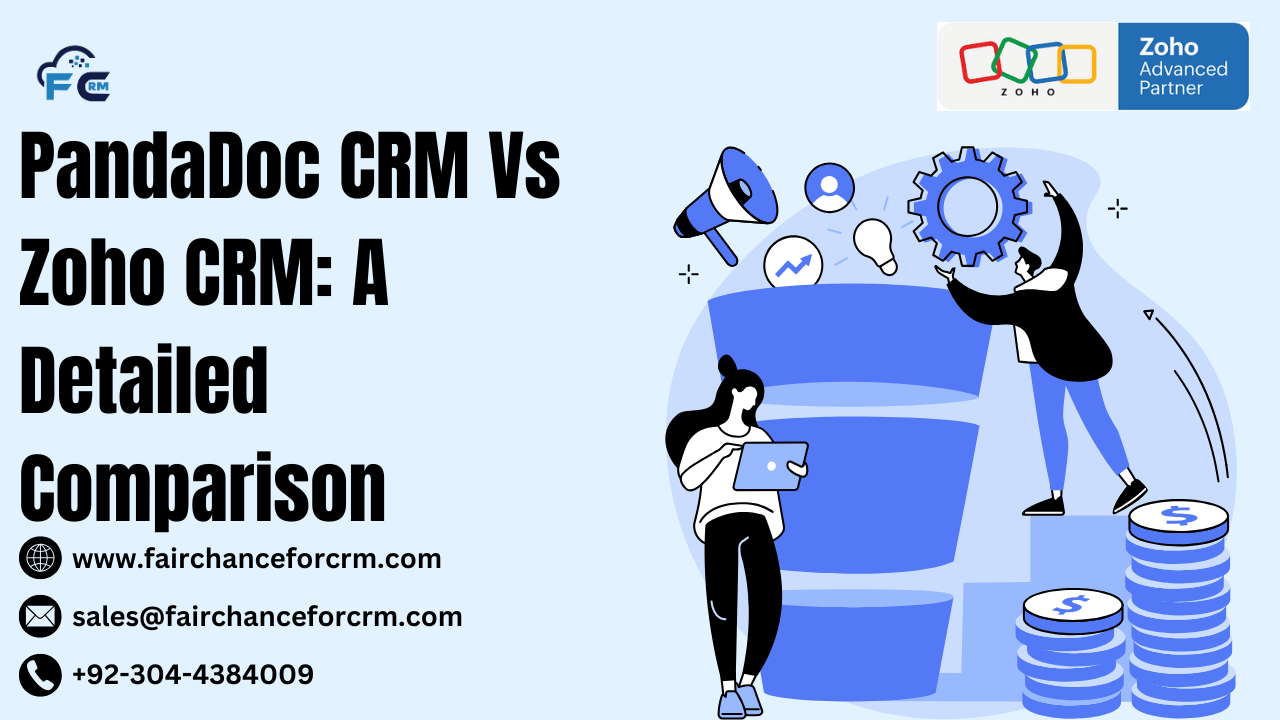In the world of Customer Relationship Management (CRM) systems, businesses have a wide array of choices, each tailored to different needs. PandaDoc CRM Vs Zoho CRM are two platforms that frequently get compared, but they serve distinct purposes within the CRM landscape. While both can help streamline sales processes and improve customer management, they do so in different ways.
This article comparesPanda Doc CRM Vs Zoho CRM across several factors, such as features, pricing, integrations, and more, to help you determine which is the better choice for your business.
Also Read:
- Teamgate CRM Vs Zoho CRM: A Comprehensive Comparison
- Freshsales CRM vs Zoho CRM: A Detailed Comparison for 2025
- SAP CRM vs Zoho CRM: A Detailed Comparison for 2025
- Nimble CRM vs Zoho CRM: A Comprehensive Comparison for 2025
- Zoho Finance Plus – FAIRCHANCE FOR CRM
PandaDoc CRM Vs Zoho CRM
1. Overview
- PandaDoc CRM: PandaDoc is primarily a document automation platform that helps businesses create, manage, and e-sign documents. While it’s not a full-fledged CRM like some others, it offers CRM functionalities primarily focused on document generation, contract management, and e-signature workflows. It’s great for businesses that need to streamline contract creation and document management as part of their sales processes.
- Zoho CRM: Zoho CRM, on the other hand, is a comprehensive CRM solution used by businesses of all sizes. It covers everything from lead generation and sales automation to customer support and analytics. With robust integrations and advanced AI features, Zoho CRM is designed for companies that need to manage the entire customer lifecycle, from acquisition to retention.
2. Core Features
- PandaDoc CRM:
- Document Creation and Management: PandaDoc excels in creating documents, proposals, contracts, and quotes. It simplifies the process of drafting, sending, and managing important documents with features like templates, drag-and-drop document editing, and e-signatures.
- E-Signatures: PandaDoc’s e-signature functionality is one of its most important features, allowing businesses to collect signatures easily and securely within their CRM.
- Pipeline Management: While PandaDoc doesn’t offer a full CRM solution, it includes basic pipeline management that integrates document-related sales processes.
- Analytics & Tracking: PandaDoc provides insights into how recipients interact with your documents—such as which sections they viewed and how long they spent on each page.
- Zoho CRM:
- Lead & Contact Management: Zoho CRM provides comprehensive tools for managing leads, contacts, and accounts, allowing users to track communication history and manage customer data.
- Sales Automation: Zoho CRM includes powerful tools for automating repetitive tasks, such as follow-up emails, lead assignment, and reminders, helping sales teams focus on higher-value activities.
- AI Insights (Zia): Zoho’s AI assistant, Zia, offers predictive analytics, lead scoring, and insights based on customer interactions, helping sales teams make smarter decisions.
- Multichannel Communication: Zoho CRM integrates with email, phone, social media, and live chat, offering a holistic view of customer interactions across various touchpoints.
- Customization & Integration: Zoho CRM is highly customizable and integrates seamlessly with over 500 third-party apps, including Zoho’s own suite of tools like Zoho Books and Zoho Desk.
3. Ease of Use and Interface
- PandaDoc CRM: PandaDoc has a user-friendly interface designed around document creation and management. Its drag-and-drop editor makes it easy for sales teams to generate and edit proposals or contracts without needing technical expertise. However, as a document-centric platform, PandaDoc doesn’t have as broad a set of features as a full CRM system, and its sales pipeline tools are more basic.
- Zoho CRM: Zoho CRM offers a clean, intuitive interface, but with many more features and customization options, it can be a bit overwhelming for new users. However, once you get used to the platform, Zoho provides a highly flexible user experience. The interface allows users to create custom dashboards, workflows, and reports, which is helpful for teams with specific needs.
4. Pricing – PandaDoc CRM Vs Zoho CRM
- PandaDoc CRM: PandaDoc’s pricing is based on the features required and the number of users. While the PandaDoc Essentials plan starts at around $19 per user per month, the cost increases as you add advanced features such as e-signatures, payment integrations, and more. The focus is on businesses that need to integrate document creation and contract management into their sales workflow.
- Zoho CRM: Zoho CRM offers a more comprehensive pricing structure, starting with a free plan for small teams (up to 3 users). Paid plans begin at $14 per user per month for the basic plan and go up to $52 per user per month for the enterprise-level plan, which offers advanced features like AI insights, sales forecasting, and custom automation. Zoho CRM’s pricing is scalable and affordable for businesses of all sizes.
5. Integrations
- PandaDoc CRM: PandaDoc integrates with a variety of tools, but its ecosystem is more focused on document-related integrations. It integrates with popular CRM platforms like Salesforce, HubSpot, and Pipedrive, as well as tools like Google Drive, Dropbox, and Zapier. If you already use one of these CRMs, PandaDoc can seamlessly fit into your workflow for document automation.
- Zoho CRM: Zoho CRM provides extensive integration options with over 500 third-party applications, including email marketing platforms, accounting software, customer service tools, and more. Additionally, it integrates well with other Zoho products (like Zoho Books, Zoho Campaigns, and Zoho Desk), making it a powerful option for businesses already using the Zoho ecosystem.
6. Customer Support – PandaDoc CRM Vs Zoho CRM
- PandaDoc CRM: PandaDoc offers customer support through email, live chat, and phone (for higher-tier plans). It also provides a knowledge base, guides, and tutorials to help users get the most out of the platform. The support experience is generally praised for being responsive and helpful.
- Zoho CRM: Zoho CRM offers robust customer support, including 24/7 assistance through phone, email, and live chat for paid plans. The Zoho support team is known for its responsiveness, and the platform also provides access to an extensive knowledge base, tutorials, and a user community to troubleshoot issues.
7. Security and Compliance
- PandaDoc CRM: PandaDoc provides SSL encryption, two-factor authentication, and secure cloud storage. It complies with major data protection regulations like GDPR and eSign Act, making it suitable for businesses that need to handle sensitive documents securely.
- Zoho CRM: Zoho CRM also offers advanced security features like SSL encryption, two-factor authentication, and role-based permissions to ensure secure data management. Zoho complies with global standards like GDPR, SOC 2, and ISO 27001, making it a reliable option for businesses dealing with sensitive customer data.
8. Which One is Right for You? PandaDoc CRM Vs Zoho CRM
- Choose PandaDoc CRM if:
- Your business focuses on managing and automating documents, contracts, and proposals as part of your sales process.
- You need a robust e-signature solution integrated into your sales workflow.
- You already use another CRM and want to integrate document automation into your existing processes.
- Choose Zoho CRM if:
- You need a comprehensive CRM solution that covers sales automation, lead management, customer support, and multichannel communication.
- Your business requires extensive customization and reporting features.
- You’re looking for a flexible, scalable CRM that integrates with a wide range of tools and third-party applications.
Conclusion
While both PandaDoc CRM Vs Zoho CRM have their strengths, the key difference is their focus. PandaDoc CRM is a powerful document management platform designed for businesses that need to automate document workflows, including proposals, contracts, and e-signatures. On the other hand, Zoho CRM is a full-featured, all-encompassing CRM that focuses on sales, marketing, and customer service automation.
If you are specifically looking to improve document creation and contract management within your sales process, PandaDoc is the better choice. However, if you need a more complete CRM solution that handles everything from lead generation to customer support, Zoho CRM is likely the better fit for your business needs.
For more information about the PandaDoc CRM Vs Zoho CRM: visit this link.
If you want to Free Trail Zoho, click on this link.




